多くの成功したサイトオーナーは、最初のWordPressサイトを見て、本当にコンテンツが読まれているのだろうかと疑問に思ったことを覚えていることだろう。
最初のうちは、訪問者をトラッキングしたり、訪問者の行動を理解したりする方法がわからないのが普通です。Google アナリティクスのようなツールの出番です。
人々があなたのコンテンツにどのように接するかを知ることは、あなたのサイトを成長させる鍵です。忠実な読者を作りたいかもしれません。あるいは、売上を伸ばしたり、ニッチな分野で投稿者を増やそうとしているかもしれません。
どのような目標であれ、サイトトラフィックデータはその達成に役立ちます。何がうまくいっているのか、何がうまくいっていないのか、どこを改善すればいいのかがわかります。
長年にわたり、私たちは数え切れないほどのサイトオーナー様のWordPressサイトへのGoogleアナリティクスインストールをお手伝いしてきました。現在でも、オーディエンスを理解し、より賢明な意思決定を行うための最良の方法です。
このガイドでは、WordPressにGoogleアナリティクスをインストールするための正確な手順を説明します。すでに大変な作業は完了していますので、手間をかけずに設定することができます。🚀

まず、なぜGoogleアナリティクスが重要なのか、そしてどのようにサイトを成長させることができるのかを説明します。
その後、Googleアナリティクスのアカウント登録方法と、WordPressサイトへのインストール方法をご紹介します。
最後に、Google アナリティクスでトラフィックレポートを表示する方法を説明します。
この投稿で学ぶことの概要を簡単に説明しよう:
- Why Is Google Analytics Important for Bloggers?
- How to Sign Up With Google Analytics
- How to Install Google Analytics in WordPress
- Method 1: Google Analytics for WordPress by MonsterInsights
- Method 2: Install Google Analytics in WordPress With WPCode
- Method 3: Install Google Analytics in WordPress Theme
- Viewing Reports in Google Analytics
- Making the Most Out Of Google Analytics
- Video Tutorial
準備はいいかい?始めよう
なぜGoogleアナリティクスはブロガーにとって重要なのか?
ブログを始めたら、一番の目標はトラフィックと購読者を増やすことです。Google アナリティクスは、重要な統計情報を表示することで、データに基づいた意思決定を支援します。見ることができます:
誰があなたのサイトを訪問しますか?
アナリティクスのこの部分には、ユーザーの地理的な位置、ユーザーがサイトを訪問する際に使用したブラウザー、画面の解像度、JavaScriptのサポート、Flashのサポート、言語などのその他の重要な情報が表示されます。
このデータは非常に便利で、さまざまな面で役立ちます。カスタムサイトのデザインを作成する際、ユーザーデータを使用して、サイトがオーディエンスに適合していることを確認することができます。
ほとんどのユーザーがFlashをサポートしていないのであれば、サイトにFlash要素を追加するのは避けるべきです。ユーザーのほとんどが1280の画面解像度を使用している場合は、その解像度以下に対応したデザインにしてください。
あなたのサイトを訪れた人は何をするのか?
ユーザーがサイトのどこに移動しているのか、どれくらいの時間滞在しているのか、直帰率(初回訪問時にサイトを離脱したユーザーの割合)などをトラッキングすることができます。
この情報を使うことで、直帰率を減らし、ページビューを増やすことができる。
また、最も人気のある投稿、あまりうまくいっていない投稿、ユーザーが求めているコンテンツも見つけることができます。
人々はいつサイトを訪れるのか?
あなたのサイトで1日のうち最もホットな時間帯を調べることで、投稿を公開するのに最適な時間を選ぶことができます。その時間帯があなたの時間帯と合わない場合は、その時間帯に投稿をスケジュールすることができる。
人々はどのようにしてあなたのサイトを見つけるのでしょうか?
アナリティクスのこのセクションは、ユーザーがどこから来たかを示します。例えば、検索エンジンを利用したのか、直接リンクを入力したのか、他のサイトからのリファラーリンクをクリックしたのか。
また、それぞれのソースからの訪問者の割合も表示されます。Google アナリティクスでは、これらのカテゴリーごとの内訳を見ることができます。検索エンジンのカテゴリーであれば、Google、Yahoo、Bingなど、どの検索エンジンからのトラフィックが最も多いかがわかります。
参照元の内訳を見れば、どのサイトと最も連携する必要があるかがわかる。リファラーの参照元がFacebookであれば、Facebook限定のコンテンツが必要です。
リファラーの参照元が外部のサイトである場合、そのサイトとの提携(ゲスト投稿の交換など)を検討するとよいだろう。
人々はあなたのコンテンツにどのように接しているのか?
Google アナリティクスは、ユーザーがサイトのコンテンツにどのようにアクセスしているかを表示します。ユーザーの何パーセントがあなたのサイトのどのリンクをクリックしたかなどがわかります。
Google アナリティクスでコンテンツ実験を行うことで、A/Bスプリットテストを実施し、目標を達成するために何が最も効果的かを理解することができます。
ユーザーのインタラクティブ性を見ることで、ユーザーに合わせてコンテンツを作成することができます。上記の質問に対する答えを見ることで、サイトに効果的な戦略に集中し、効果的でない方法を避けることができます。
簡単に言えば、推測を排除し、重要な統計に集中することで、データに基づいた意思決定ができるようになる。
Google アナリティクスへの登録方法
Googleアナリティクスは無料で利用でき、登録に必要なのはGoogleまたはGmailのアカウントだけだ。登録方法はとても簡単です。以下のステップバイステップの手順に従って、Googleアナリティクスアカウントを作成するだけです。
ステップ1:まず、Googleアナリティクスのサイトにアクセスして登録します。サイトにアクセスしたら、「今すぐ始める」ボタンをクリックします。
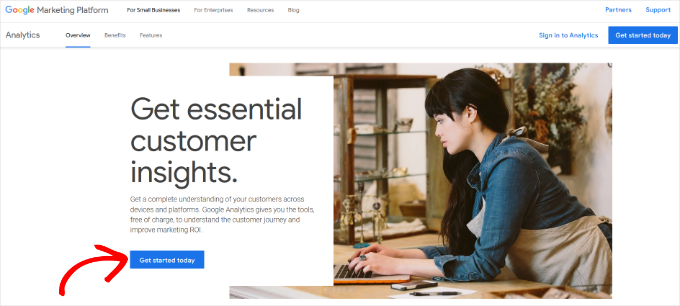
次に、Googleアカウントでログインするよう求められます。
すでにGoogleやGmailのアカウントを持っている場合は、それを使ってログインできます。そうでない場合は、Googleアカウントを作成してください。
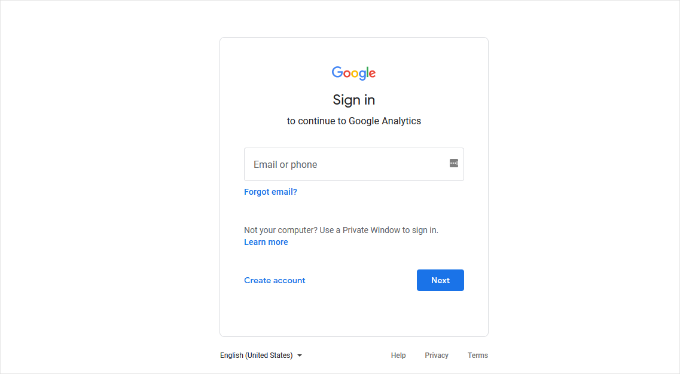
ステップ2:Gmailアカウントでサインインすると、以下のようなウェルカム画面が表示されます。
ここでGmailアカウントを使ってGoogleアナリティクスに登録します。測定開始」ボタンをクリックしてください。

その後、アカウント名の入力を求められます。
この名前は社内で使用されるため、ビジネスネームのように何でも使用できます。
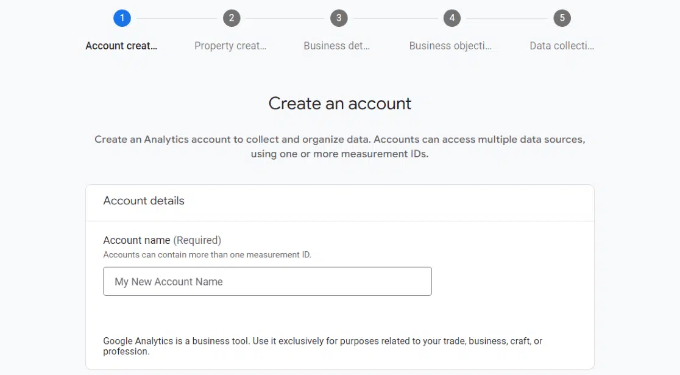
Google アナリティクスでは、複数のアカウントのデータ共有設定も表示されます。
これらの設定により、Googleアナリティクスデータの共有をコントロールすることができます。初期設定のまま次のステップに進んでください。

ステップ3:次の画面では、Googleアナリティクスのプロパティを作成する必要があります。
Googleは、Googleアナリティクス4またはGA4と呼ばれるアナリティクスの新バージョンを導入しました。これは、サイトとモバイルアプリを同じアカウントでトラッキングする最新バージョンです。さらに、新しい機能、測定基準、レポートのインターフェースが追加されました。
プロパティ名を入力し、レポートのタイムゾーンと通貨を選択します。次に「次へ」ボタンをクリックします。
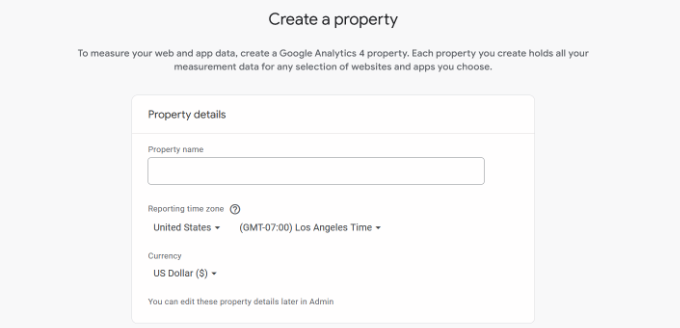
次の画面では、ドロップダウンメニューからあなたのサイトの「カテゴリー」を選択し、所定のオプションから「ビジネスサイズ」を選択する必要があります。
完了したら、「次へ」ボタンをクリックします。
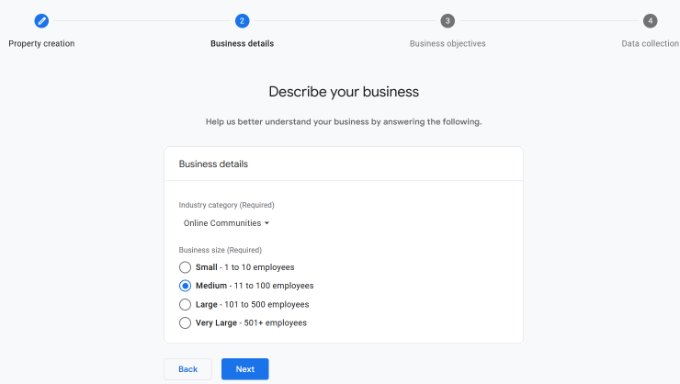
次に、ビジネスの目的を選択し、Google アナリティクスをどのように使用するかを選択する必要があります。これにより、あなたのビジネスにパーソナライズされたレポートを得ることができます。
例えば、リードの生成、オンライン販売の促進、ブランド認知度の向上、ユーザー行動の調査などのオプションがある。
複数のオプションを設定することも、ニーズに合わせて指定されたオプションのすべてを選択することもできます。ベースラインレポートを取得する」オプションを選択すると、Google アナリティクスレポートがすべてアカウントに反映されます。
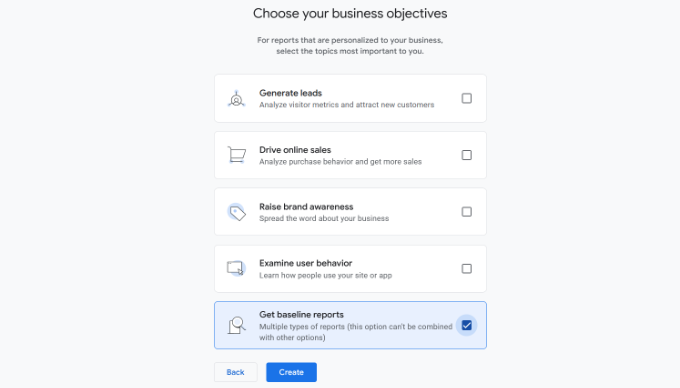
完了したら、「作成」ボタンをクリックするだけです。
ステップ4:Google アナリティクス ウェブストリーム オプションが表示されます。
WordPressサイトにGoogleアナリティクスを設定するので、プラットフォームとして「Web」を選択します。
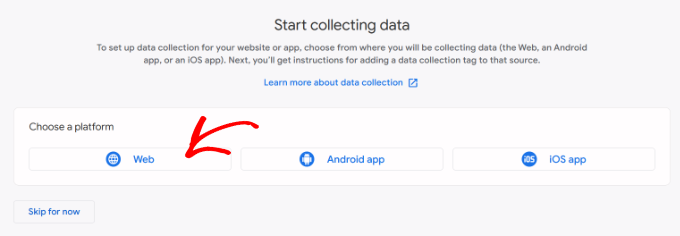
その後、サイトのURLとストリーム名を入力します。
初期設定では、Googleアナリティクスは「拡張測定」オプションを有効化しています。これにより、Googleアナリティクスでページビュー、スクロール、送信クリック、ファイルダウンロードなどをトラッキングできるようになります。
📝注意: MonsterInsightsプラグインを使用する予定がある場合は、’Enhanced measurement’オプションをオフにしてください。そうしないと、プラグインは2倍の量のデータを収集し、表示します。
次に、「ストリームを作成」ボタンをクリックします。
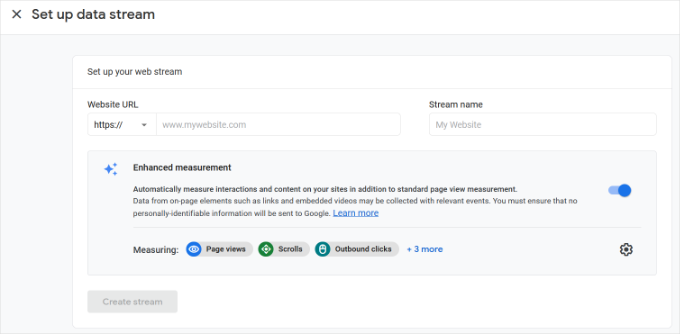
ストリーム名、URL、ID、測定IDが表示されます。
また、記録されるさまざまな強化測定値も表示される。
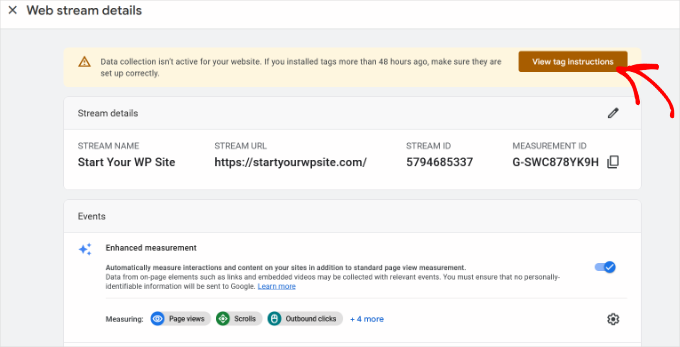
上部には、GoogleアナリティクスをWordPressサイトに追加する方法を示すアラートバーも表示されます。
タグの表示」ボタンをクリックしてください。これで、WordPressサイトにGoogle アナリティクスのトラッキングコードを追加するさまざまな方法が表示されるはずです。
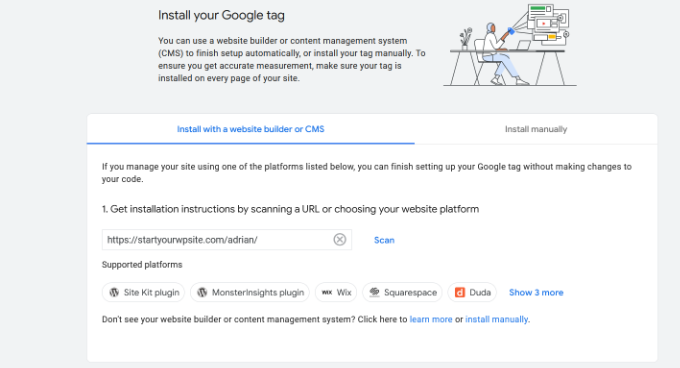
次に、「手動でインストール」タブに切り替えます。
Google アナリティクスのトラッキングコードが表示されます。
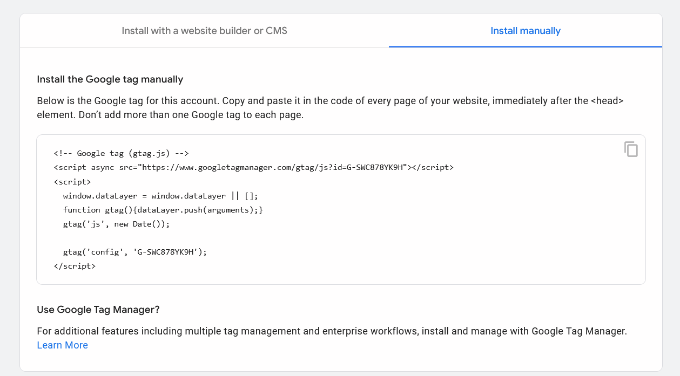
このトラッキングコードをコピーして、WordPressサイトに入力する必要があります。また、このブラウザータブを開いたままにしておき、必要なときに切り替えてコードをコピーすることもできます。
アナリティクス」のブラウザー・タブは開いたままにしておくことをお勧めします。WordPressサイトにコードをインストールしたら、再訪問する必要があるかもしれないからです。
Google アナリティクスのアカウントを設定したところで、WordPressにGoogle アナリティクスをインストールする方法を見ていきましょう。
WordPressにGoogleアナリティクスをインストールする方法
WordPressでGoogleアナリティクスを設定するには、いくつかの方法があります。ここでは3つの方法を紹介するが、最初のオプションが最も簡単で、最後のオプションが最も難しい。
自分のニーズに合ったものを選ぶことができる。
💡プロからのアドバイス:Googleアナリティクスアカウントでページビューの二重トラッキングを避けるために、サイトでこれらの方法のうち1つだけを使用する必要があります。
方法1:MonsterInsightsによるWordPress用Googleアナリティクス
MonsterInsightsは、WordPress用の最も人気のあるGoogleアナリティクスプラグインです。Bloomberg、PlayStation、Zillow、WPBeginnerなど、300万以上のサイトが利用しています。
MonsterInsightsは、WordPressにGoogleアナリティクスを追加する最も簡単で、圧倒的に優れた方法です(初心者から上級者まで、すべてのユーザーにとって)。MonsterInsightsは有料のプレミアムプラグインと無料版の両方があります。
WPBeginnerでは、フォーム送信、CTAボタンのクリック、リファラーリンクのパフォーマンスなど、さまざまなトラッキングタスクにMonsterInsightsを使用しています。なぜMonsterInsightsが素晴らしいプラグインなのかは、MonsterInsightsのレビューをご覧ください。
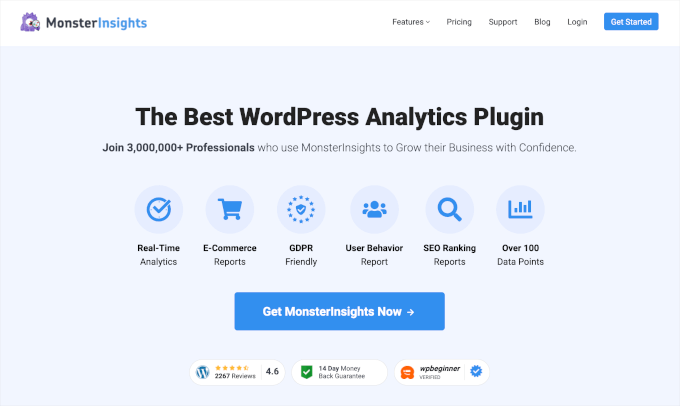
このチュートリアルでは、MonsterInsights無料版を使用します。
eコマーストラッキング、広告トラッキング、著者トラッキングなど、より高度な機能をご希望の場合は、MonsterInsights Proバージョンをご利用ください。設定方法は同じです。
始めよう。
まず最初に、MonsterInsightsプラグインをインストールして有効化します。詳しくは、WordPressプラグインのインストール方法のステップバイステップガイドをご覧ください。
プラグインを有効化すると、WordPressの管理メニューに「Insights」という新しいメニュー項目が追加され、ようこそ画面が表示されます。Launch the Wizard」ボタンをクリックしてください。

クリックするとMonsterInsightsのセットアップウィザードが開きます。
まず、ウェブサイト(ビジネスサイト、ブログ、オンラインストア)のカテゴリーを選択するよう求められます。いずれかを選択し、「保存して続行」ボタンをクリックします。
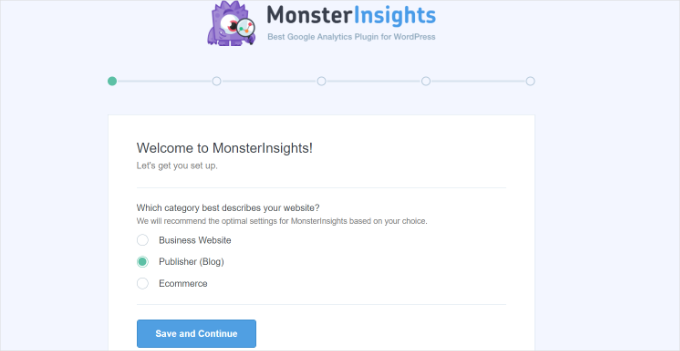
次に、MonsterInsightsとWordPressサイトを接続する必要があります。
MonsterInsightsを接続する」ボタンをクリックするだけです。
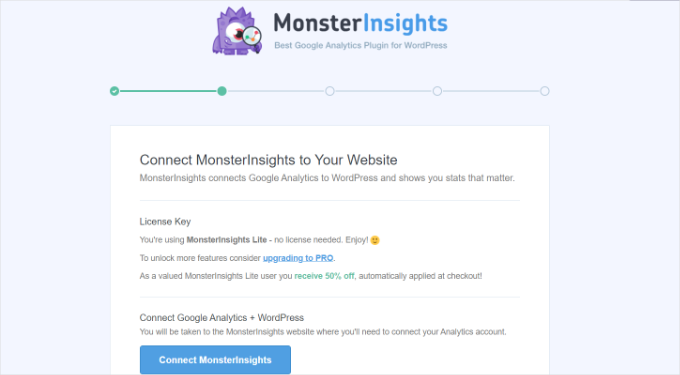
ログインするか、すでにログインしている場合はGoogleアカウントを選択します。
Googleアカウントを選択するか、メールを入力してログインしてください。
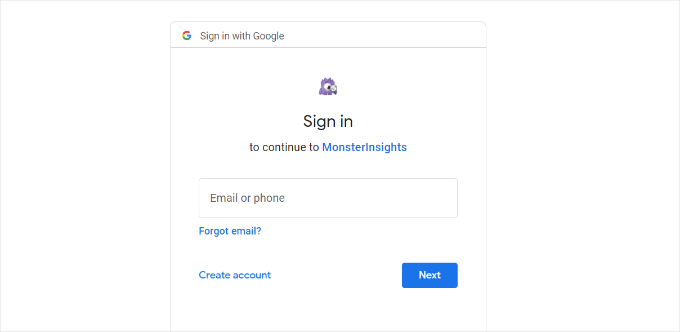
次に、MonsterInsightsがGoogleアナリティクスアカウントにアクセスすることを許可するよう求められます。
許可」ボタンをクリックして続行する。
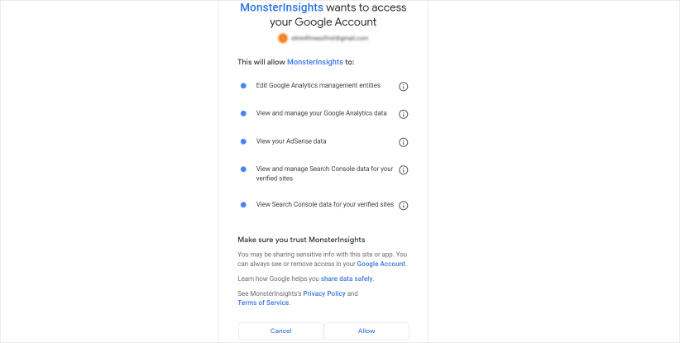
接続を完了するための次のステップは、追跡したいプロフィールを選択することです。
ここでサイトを選択し、「Complete Connection(接続を完了する)」ボタンをクリックして続行します。
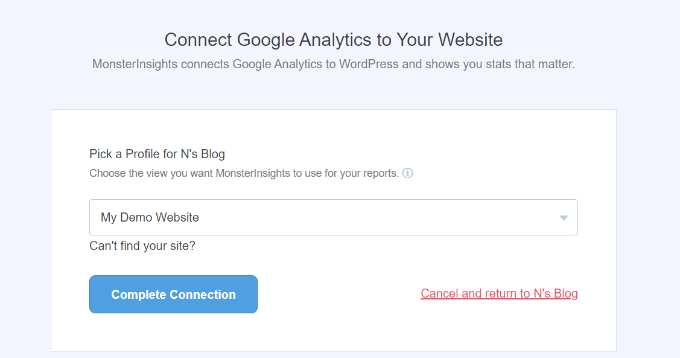
その後、「Complete Connection」ボタンをクリックしてください。これでMonsterInsightsがあなたのサイトにGoogleアナリティクスをインストールします。
次に、サイトの推奨設定を選択するよう求められます。
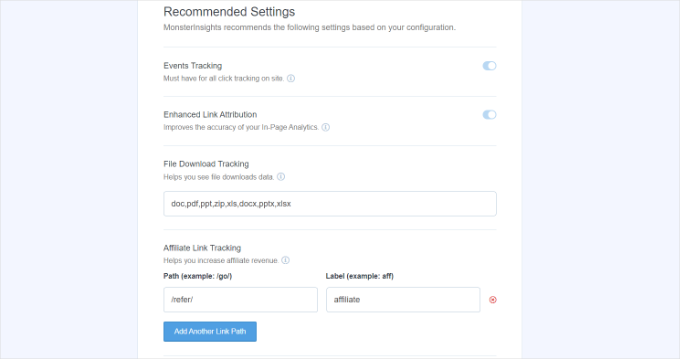
初期設定はほとんどのサイトで機能します。アフィリエイトリンクのプラグインを使用している場合は、アフィリエイトリンクのクロークに使用するパスを追加する必要があります。これにより、Googleアナリティクスでアフィリエイトリンクをトラッキングできるようになります。
MonsterInsightsはまた、誰がレポートを見ることができるかを尋ねます。WordPressのユーザー権限グループを選択することができます。
設定が完了したら、「Save and Continue(保存して続行)」ボタンをクリックして設定を保存します。
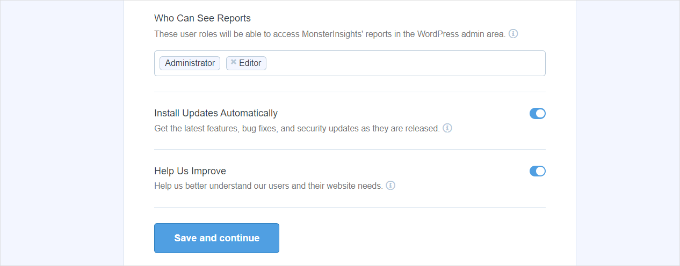
次に、MonsterInsightsが有効化したいトラッキングサイトのリストを表示します。
下にスクロールして「Continue」ボタンまたは「Skip for Now」オプションをクリックします。
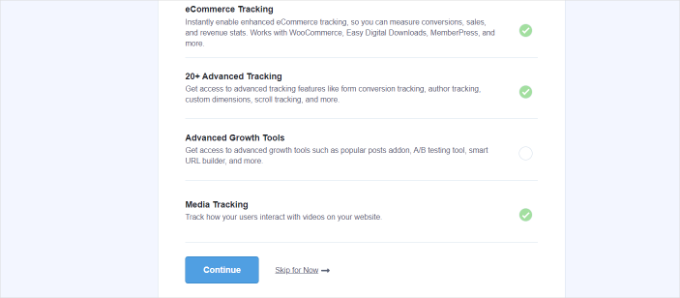
次の画面では、MonsterInsightsがGoogleアナリティクスのトラッキング設定に成功したことを表示します。
Google アナリティクスが接続され、トラッキングコードがインストールされ、データが収集されていることがわかります。
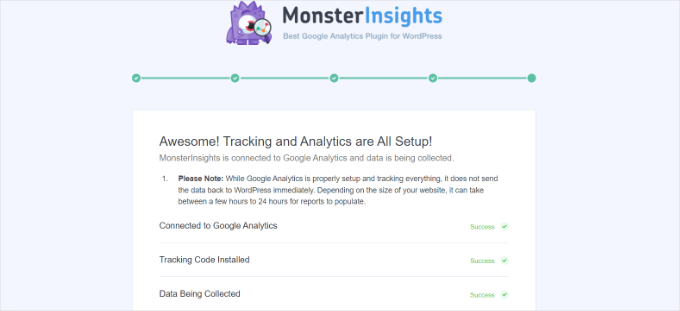
次に下にスクロールすると、ライセンスキーを入力する欄があります。
アップグレードせずにセットアップを完了する」オプションをクリックします。
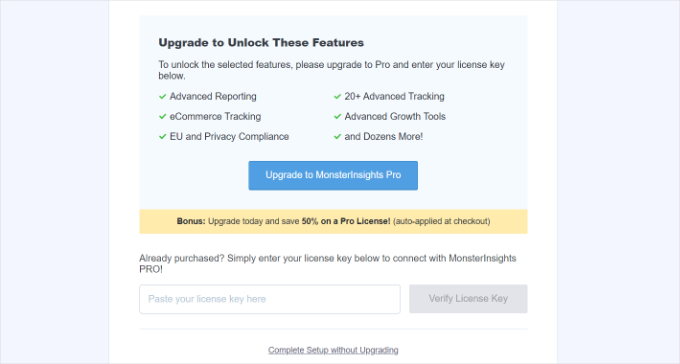
WordPress サイトに Google アナリティクスを追加できました。
Google アナリティクスで拡張測定の無効化
GA4でMonsterInsightsにデータストリームを作成させる代わりに、自分でデータストリームを作成した場合は、Enhanced Measurementをオフにする必要があります。
それは、MonsterInsightsが複数のカスタム拡張トラッキング機能を追加しているからです。拡張測定オプションを有効化したままにしておくと、データに歪みが生じ、正しくない結果が表示されます。
まず、ブラウザーでGoogleアナリティクスのタブまたはウィンドウにアクセスします。ここから、左下にある「管理者」設定オプションをクリックします。
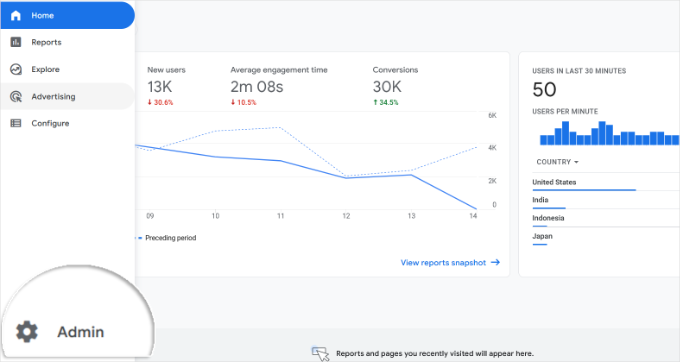
管理者」ページに入ると、さまざまな設定が表示されます。
データストリーム’オプションをクリックするだけです。
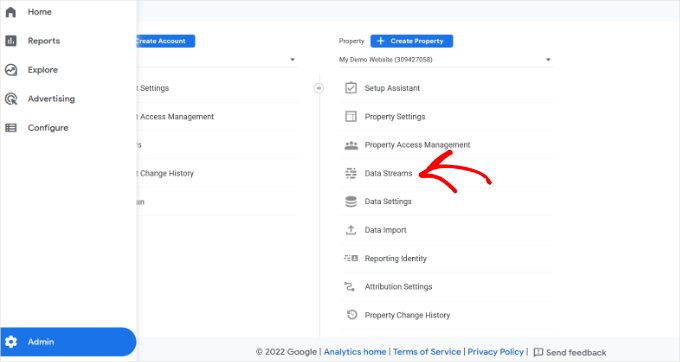
次に、データストリームが表示されます。
MonsterInsightsで接続したデータストリームを選択するだけです。
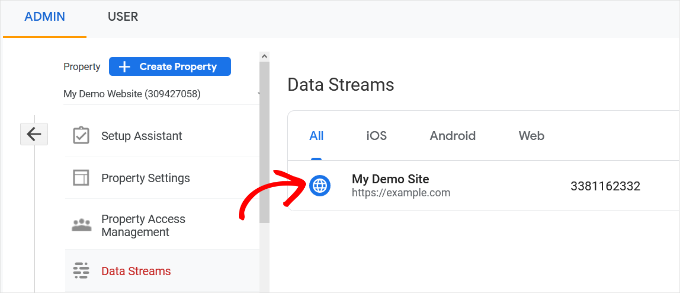
次の画面で、’Enhanced measurement’ オプションを無効化する必要があります。
トグルをクリックするだけです。
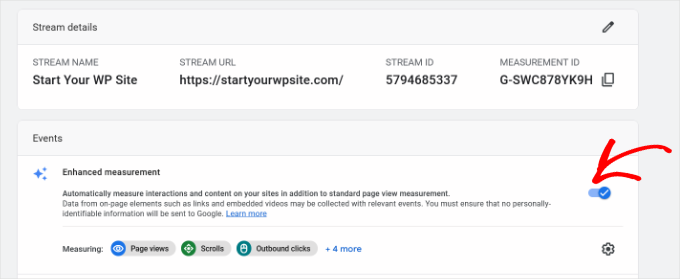
次にポップアップウィンドウが開き、強化測定をオフにすることを確認します。
オフにする」ボタンをクリックしてください。
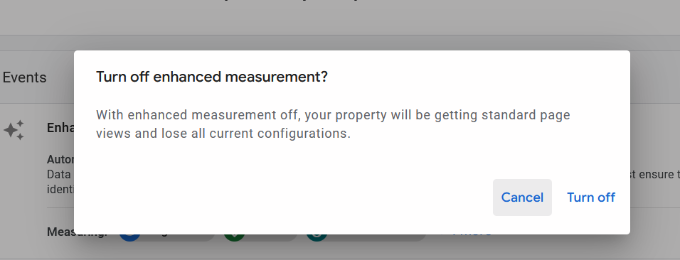
Google アナリティクスでデータ保持設定を変更する
初期設定では、Googleアナリティクスはデータ保持設定を2ヶ月に設定します。しかし、これを変更することで、2ヶ月を超えてもカスタムレポートでデータを使用できるようになります。
まず、管理 ” データ設定 “Googleアナリティクスのデータ保持にアクセスします。
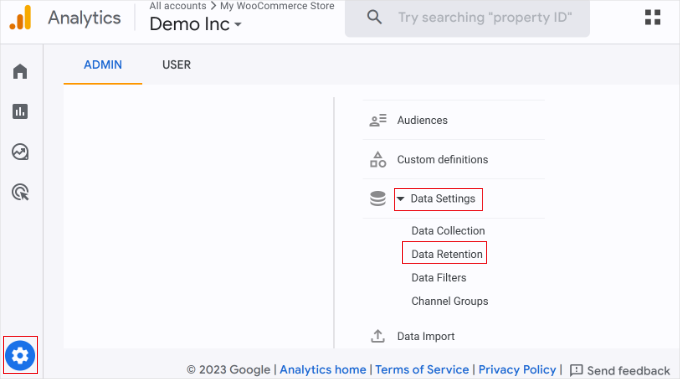
次に、「イベントデータ保持」のドロップダウンメニューをクリックします。
ここから、「14ヶ月」オプションを選択し、「保存」ボタンをクリックするだけです。
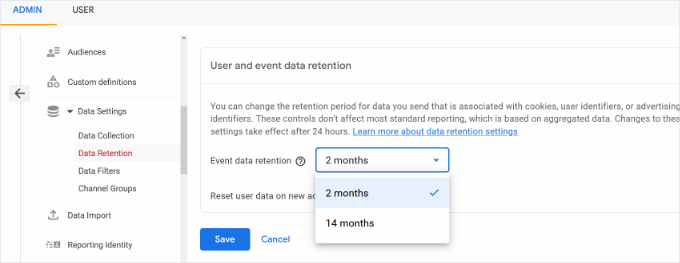
Google アナリティクスが統計情報を表示するまでに時間がかかることを忘れないでください。
💡プロのヒント:Google アナリティクスでは、データの保存期間を14ヶ月に延長することができますが、初期設定の2ヶ月を選択した場合でも、GDPRのようなプライバシー規則は適用されます。
そのため、トラッキングを行う前にユーザーの同意を得る必要があります。また、プライバシーポリシーにデータの保存期間を記載しておくと良いでしょう。
どのように始めたらよいかわからないですか?GDPR/CCPAのためにWordPressでCookieポップアップを追加する方法については、こちらのガイドをご覧ください。
WordPressダッシュボード内でGoogleアナリティクスレポートを表示する
MonsterInsightsの最も優れた点は、WordPressダッシュボード内でGoogleアナリティクスレポートを表示できることです。
インサイト ” レポートページで、アナリティクスデータの概要を簡単にチェックできます。
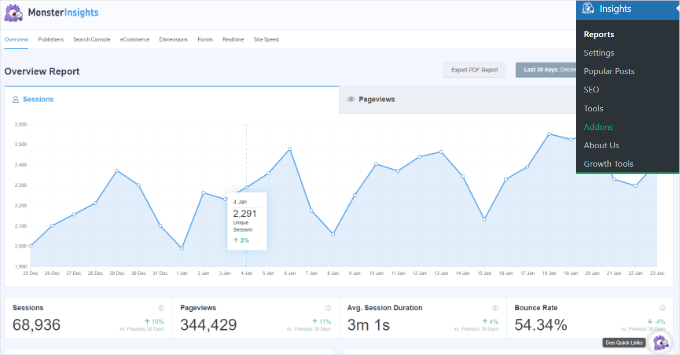
また、MonsterInsightsのレポートに直接注釈を追加して、サイトに加えた主な変更を記録することもできます。
例えば、新しいブログ投稿を公開した時、新しいランディングページを追加した時などにメモを追加することができます。これにより、これらのイベントがトラフィックにどのような影響を与えたかをトラッキングしやすくなります。
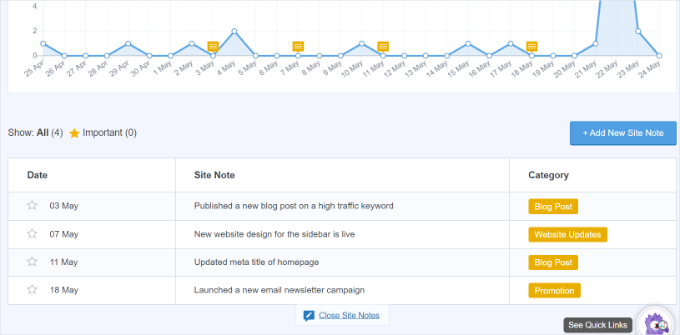
詳しくは、WordPressでGA4サイトアノテーションを取得する方法をご覧ください。
MonsterInsightsの新機能「会話AI」によって、興味のあるサイトの統計について質問することもできます。
例えば、eコマースのサイトを持っている場合、特定の期間に製品からどれだけの収益を上げたかを尋ねることができます。
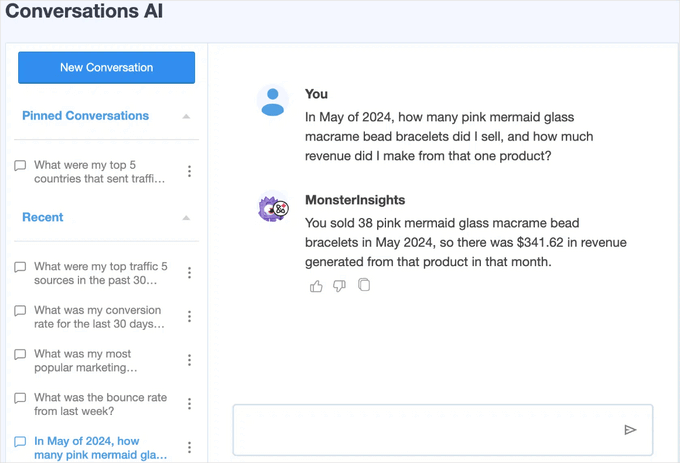
特にアナリティクスを始めたばかりの場合は、必要なデータを探すためにレポートを検索するよりもはるかに簡単です。
さらに、MonsterInsightsにはPopular Postsアドオンが付属しており、トラフィックとページビューを増加させるために、パフォーマンスの高いコンテンツを表示することができます。
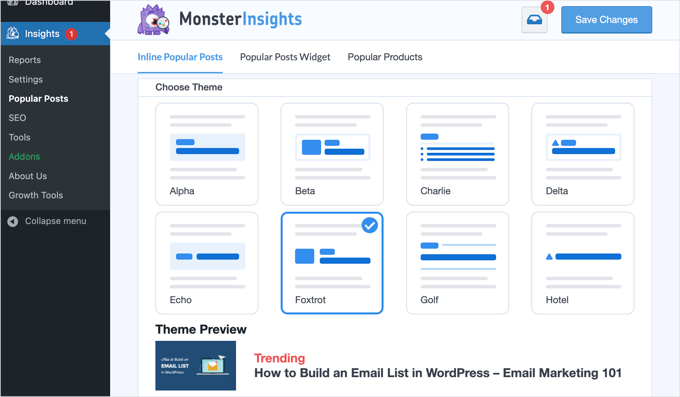
人気投稿のインラインリンクを自動的に追加して、エンゲージメントを高めることができます。
オンラインショップを運営している場合は、各ブログ投稿の末尾に売れ筋商品を自動的に追加して、売上を伸ばすこともできる:

WordPressブログを運営しているなら、Page Insightsアドオンが超便利だ。
インストーラをインストールすると、「すべての投稿」画面、フロントエンド(ログイン中)、コンテンツエディター画面にブログの統計情報が自動的に追加されます。
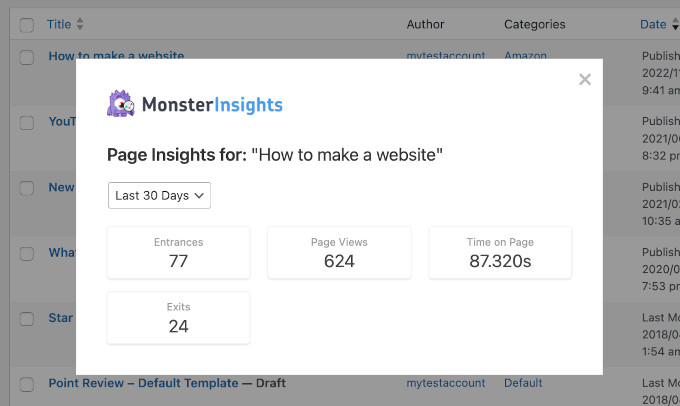
🌟インサイダー注:MonsterInsightsは以前、Google アナリティクス for WordPress by Yoastとして知られていました。WPBeginnerの創設者であるSyed Balkhiは、2016年にこのプラグインを買収し、MonsterInsightsにリブランドしました。現在は、当社のプレミアムWordPressプラグインファミリーの一部となっています。
方法2:WPCodeを使ってWordPressにGoogle アナリティクスをインストールする
この方法では、手動でWordPressにGoogleアナリティクスをインストールする方法をご紹介します。WPCodeを使ってGA4トラッキングコードをサイトのヘッダーに追加します。
⚠️ はじめに、この方法は高度なトラッキング設定ができないため、MonsterInsightsほど優れていないことにご注意ください。また、WordPressダッシュボードでGoogleアナリティクスのデータを表示することもできません。
WPCodeプラグインを使用すると、テーマファイルを編集することなく、WordPressサイトにカスタムコードスニペットを安全に追加することができます。
私たちのビジネスパートナーの一部は、トラッキングスクリプト、カスタマイザー機能、およびその他の高度な設定を管理するためにWPCodeを使用しており、それは非常にうまく機能しています。プラグインについてさらに詳しく知りたい方は、WPCodeのレビューをご覧ください!

まず、先ほどのステップ4でGoogleアナリティクスのアカウント作成時にコピーしたトラッキングコード(グローバルサイトタグ)をコピーします。
インターフェースはこんな感じだ:

次に、WPCodeプラグインをインストールし、有効化する必要があります。詳しくは、WordPressプラグインのインストール方法のステップバイステップガイドをご覧ください。
📝注意: 無料のWPCodeプラグインを使って、Googleアナリティクスのトラッキングコードをインストールすることができます。
しかし、WPCode Proにアップグレードすることで、より強力な機能が利用できるようになります。例えば、完全なリビジョン履歴で変更を追跡したり、コードスケジューリングで特定の時間にスニペットを自動的に有効化または無効化することができます。
有効化したら、Code Snippets ” Header & Footerページにアクセスする必要があります。ここで、先ほどコピーしたGoogleアナリティクスのトラッキングコードを「ヘッダー」セクションにペーストしてください。
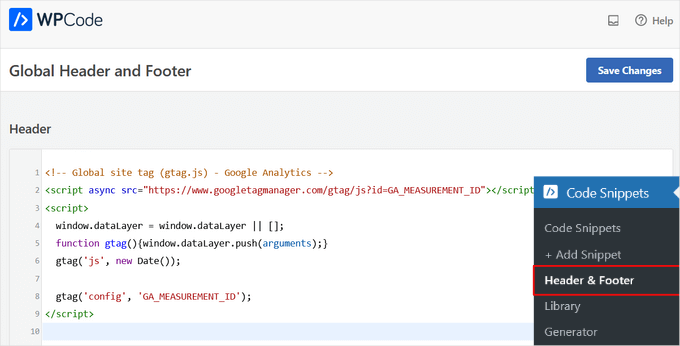
変更を保存」ボタンをクリックして、設定を保存することを忘れないでください。
以上で、Google アナリティクスのサイトへのインストールはすべて完了です。
方法3:WordPressテーマにGoogleアナリティクスをインストールする
この方法は、コードに詳しい上級ユーザー向けだ。テーマを変更したり更新したりするとコードが消えてしまうので、やや信頼性に欠ける。
この方法を使うことはほとんどお勧めしない。
WordPressファイルにコードを追加するのが初めての場合は、WordPressでコードスニペットをコピー&ペーストする方法をご覧ください。
まず、ステップ4でコピーしたGoogleアナリティクスのトラッキングコードをコピーします。ウェブストリームインストールセクションの「手動インストール」タブで表示できます。

WordPressテーマ・ファイルにこのコードを追加する一般的な方法は2つあります。どちらか一方を選べばよい(両方は不可)。
1.header.phpファイルにコードを追加する
WordPressテーマのheader.phpファイルを編集し、<body>タグの直後に先ほどコピー&ペーストしたGoogleアナリティクスのトラッキングコードを貼り付けるだけです。
変更を保存し、サーバーにファイルをアップロードすることを忘れないでください。
2.関数ファイルによる追加
GoogleアナリティクスのトラッキングコードをWordPressの関数ファイルに追加することもできます。そうすれば、WordPressサイトのすべてのページにトラッキングコードが自動的に追加されます。
テーマのfunctions.phpファイルにこのコードを追加する必要があります。
1 2 3 4 5 6 7 | <?phpadd_action('wp_head', 'wpb_add_googleanalytics');function wpb_add_googleanalytics() { ?> // Paste your Google Analytics tracking code from Step 4 here <?php } ?> |
上記のスニペット内の「Paste your Google アナリティクス tracking code from Step 4 here(ステップ4で使用したGoogleアナリティクスのトラッキングコードをここに貼り付ける)」の部分を、Googleアナリティクスのコードに置き換えることをお忘れなく。
Google アナリティクスでレポートを表示する
Google アナリティクスは、あなたの統計から収集されたデータの宝庫を表示することができます。Google アナリティクスのダッシュボードにアクセスすると、このデータを表示できます。
左のカラムにビルトインのGoogleアナリティクスレポートが表示されます。各セクションは異なるタブに区切られており、タブをクリックすると展開され、より多くのオプションが表示されます。
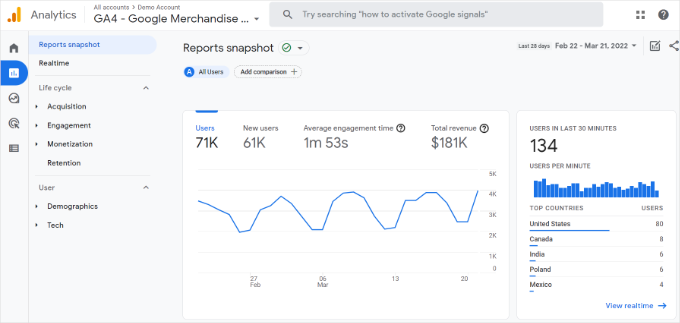
Google アナリティクス 4のレポートは、これまでのユニバーサル アナリティクスのレポートとは少し異なります。左の列には、専用のレポートオプションがあります。レポートは、ライフサイクルとユーザーを含む2つのカテゴリーにまとめられています。
GA4のレポートで最も顕著な違いの1つは、直帰率の指標がないことです。それ以外には、新しいレポートインターフェース、エンゲージメント時間のような新しい指標、GA4にゴールがないことなどがあります。
Google アナリティクス4の各種レポートの内訳は以下の通りです:
- リアルタイムレポートはユニバーサルアナリティクスに似ており、サイト上の有効化したユーザーをリアルタイムで表示します。
- 獲得レポートは、オーガニック、リファラー、メール、アフィリエイトなど、ユーザーがどの媒体を使ってあなたのサイトを見つけたかを示します。
- エンゲージメントレポートは、サイト上で発生したコンバージョンやイベントを表示します。
- マネタイズレポートは、アプリ内課金やパブリッシャー広告などの新しいレポートとともに、eコマースデータをすべて一箇所に表示します。
- リテンションレポートは、基本的に新規訪問者と再訪問者を表示し、ユーザーリテンションに関する洞察を得るのに役立ちます。
- デモグラフィックスレポートでは、上位の国や都市などからのサイトトラフィックを確認することができます。また、性別の内訳や関心度のレポートも表示されます。
- テックレポートでは、人々がどの端末、ブラウザー、オペレーティングシステム、アプリのバージョン、画面サイズを最も使用してサイトを表示しているかを表示します。
Google アナリティクスを最大限に活用しよう
Google アナリティクスは、驚くほどパワフルなツールで、素晴らしい機能がたくさんあります。その中には、ごく当たり前で簡単に使えるものもあれば、追加設定が必要なものもある。
Google アナリティクスのレポートを最大限に活用するためのリソースをご紹介します。
- Google アナリティクスで WordPress のユーザーエンゲージメントをトラッキングする
- WordPressで検索アナリティクスを見る方法
- WordPressでアウトバウンドリンクをトラッキングする
- Google アナリティクスから個人を特定できる情報を排除する方法
- Google アナリティクスでWordPressのフォームトラッキングを設定する方法
- Google アナリティクスで WooCommerce のカスタマイザーをトラッキングする
- Google アナリティクスでカスタムメールアラートを簡単に取得する方法
Google アナリティクスは、Google Search Console(旧Googleウェブマスターツール)との連携が最適です。検索結果であなたのサイトがどのように表示されているかを確認することができます。Google Search Consoleの使い方については、Google Search Console完全ガイドをご覧ください。
WordPressのSEOランキングを向上させ、より多くのトラフィックを獲得したいのであれば、オールインワンのSEOツールキットであるWordPress用AIOSEOプラグインの使用をお勧めします。
AIOSEOには無料版もあるので、そちらを使うこともできる。
このプラグインは、適切なスキーママークアップ、サイトマップ、SEOランキングを向上させるために必要なあらゆるものを使ってWordPressサイトを完全に最適化するのに役立ちます。
動画チュートリアル
その前に、WordPressにGoogle アナリティクスをインストールする方法の動画チュートリアルをお見逃しなく!▶️。
この投稿が、WordPressにGoogleアナリティクスをインストールする方法を学ぶのにお役に立てば幸いです。Google アナリティクスと Jetpack Stats の比較や、初心者のためのWordPress GA4 ガイドもご覧ください。
If you liked this article, then please subscribe to our YouTube Channel for WordPress video tutorials. You can also find us on Twitter and Facebook.





Lebo
This is awesome thank you for this
Keith
Great and simple post to follow! Thanks! Should be higher in Google in my opinion as it’s easy to follow with good screen shots.
I had trouble with adding another tracking code to my new, second site. I had to log into my Google Analytics I already had and then click on the upper right “Admin” tab/button. That led me to the page to add the new site’s info. I was trying to add a whole new Google Analytics account!
Don’t know if that will help some but wanted to share.
Great post! Thanks for the tutorial.
K
Nicholas
Thanks for this information
I have install Google Analytics on one blog, please can i use the same code for my new second blog.
Thanks.
Roel Kramer
No, if you use the same code on a second blog the Analytics code will track visitors from both websites simultaneously. You will not be able to tell the difference betwee visitors from blog 1 and visitors from blog 2. You need to use a new code for each new website.
Tahzeeb Sattar
Thank you very much, I have added to my new blog.
Sarah
Thank you for these really easy instructions. I think I’ve cracked it (took a little bit of playing around to figure out how to use the plugin). Now fingers crossed I should get the information that I’m after.
Hamza waqar
In your plugin setting we’ve to insert code in footer or header or in both ?
Please answer this ASAP. I’m stuck
WPBeginner Support
In one of them. Pasting a code in both will make the code appear twice on every page of your site.
Admin
Tommy G
Hi there,
I am trying to install my google analytics tracking code to my website via word press, and I am having a hard time getting the “insert headers and footers” plugin to install properly. I keep getting “Unable to create directory”. Anybody have any fixes to this?
WPBeginner Support
It seems that an earlier plugin install attempt ended prematurely. Go to Plugins > Installed Plugins screen and see if you have insert headers and footers there.If it is there then try activating it. Or you can connect to your website using an FTP client and go to wp-content/plugins and delete the insert-headers-and-footers directory. Try to reinstall plugin after that.
Admin
Mrkay
I had exactly the same problem. I overcame it by logging on to my ftp and changing the permissions, for the plugins folder on the host server, from 555 to 777 – which makes it writeable.
WPBeginner Support
777 is a dangerous combination of permission and it leaves your site vulnerable. Try setting it to 755 and see if this resolves your issue.
Admin
Pam Wilson
These instructions no longer work. When I sign into my google account using your link it takes me to a Security settings page. When I just searched for Google Analyltics, there are several options. I assume “standard” is the one you recommend, but there’s no nifty walk through like you lay out in your article. After searching, I found this link to get me to where you sent us (I think)
WPBeginner Support
The instructions work perfectly. Actually Google may change signup page URL. All you need to do is to visit Google Analytics website and then click on the Signup button.
Admin
Liesl
You might have already answered this but I am sick and the brain is not at 100% functioning capacity.
1) Now that I have pasted the code into my footer via settings, does that cover very page and blog on my site?
2) What is the benefit of pasting the code into the header as well as the footer?
3) When I installed your plug in it warned that it may not be compatible with the latest version of wordpress 4.2.2 And I noticed that you haven’t upgraded this version in over a year. Will it still be compatible with all of the changes?
Regards………Liesl
WPBeginner Support
Yes when you paste the code in footer, it will appear on all your WordPress pages. The header loads first and the footer loads at the end. Please see our guide on should you install plugins not tested with latest WordPress.
Admin
Chris
I’m running WordPress 4.2.2 on by blog and it says that the Insert Header and Footer plugin has not been tested on this version. Will it still work? Any other suggestions?
Thanks.
Paul Maddock
You might want to add in at the end of this article the use of the ‘Real Time’ -> ‘Overview’ report. You can immediately see if you’ve installed the tracking code correctly if you’re getting any data at all showing in GA.
I just followed this awesome guide and was able to see myself on the site, which was pretty satisfying
Nick Darlington
Hey, thanks this was a great help.
At the end, after you have pasted the code, mention going back to step 4 and clicking save?
Perhaps im being stupid, but theres no save button anywhere.
Drew
Great easy to use tutorial. Thank You!
Jayson Schlesinger
Thank you for such a simple and easy video, not a tech expert and this video made it effortless.
Josh Rachlis
Great, thanks. I’m working on launching my new self-hosted WordPress site. I just added the Insert Headers and Footers Plugin, like you suggested, and I pasted the code into Footers. So, we’ll see if it works! Do you happen to know if adding Stat Counter would help as well? I used to love looking at Stat Counter for my older blog, because it showed who was visiting and what they Googled to get to me. But, Google is hiding that info now, right? So, is there no point in having Stat Counter as well? Do you know of any work around trick to see that kind of info?
WPBeginner Support
Josh. Many users find statcounter easier to understand than Google Analytics. There is no harm in using them both on your site.
Admin
Sherluck
Hi, I installed Google analytics plugin yesterday. It does not show any data from 30 days. Does it just start tracking from the day I installed it? how can I track the last years data? Thanks
larry
Hi Sherluck,
Yes, it only starts tracking once you install Google analytics. It has no historical data.
E.S. Michelson
Good post. Thank you.
Near as I can determine Google Analytics will not work on a yourdomain.com wordpress.com account unless you upgrade to, or have, a WordPress business plan. ($299/yr.)
Bill
Thank you for the tip. I downloaded a Header/footer plugin and it worked great.
moko
Uh wow! great article.. i need this .. thanks
Maris
How to hide tracking code from page source?
Everyone can see it….
Larry
Why do you want to hide it?
There is nothing sensitive about it.
Maya Mey Aroyo
Hey,
First I wanna say that I really love this website, been using it quite a lot lately..
Second,
I already have a google analytics account on a different website (actually 2), and I can’t seem to find how to add my two new sites to that account…
I tried the help on the analytics itself, and got to the page where I can add a URL- but the fill-in boxes where grey and I had no option filling in the details. Any advice?
Cheers!
Febriyan Lukito
I want to ask about the analytics plugin itself. I use the one from Yoast. Is it recommended to install such plugin? Please help on this.
WPBeginner Support
If you find it hard to add Analytics code to your website, then you can use such plugins.
Admin
Tony McBride
Easy to follow and I liked the fact that you had the video as well as text to explain the how to.
My site is set up now for tracking, thank you!
Tony
Ahmad Tahir
I a£ using wordpress blog from wordpress.com that doesn’t allow for plugin installation. I don’t know how to access the websites files on the wordpress.com server.
WPBeginner Support
Please see our guide on the difference between WordPress.com and WordPress.org. You will need to move your WordPress.com site to a self hosted WordPress.org site if you want to use plugins and edit files. See our guide on how to move your WordPress.com blog to WordPress.org
Admin
Mieke Fassart
I had a perfectly running report until April third. After that date my traffic is zero. Can you help?
ROnald
With a multisite network of independent blogs that I administer: Do I need to install Google Analytics *before* I convert the clean WP install to a multisite network, or *after* it has been networked. I want Analytics to report on each site independently.
elizabethsusanjoseph
I followed all this information. but I am getting an error message as follows:
“Tracking code on page example.com/ does not match property example sites tracking ID UA-61……”
What might be the problem.
Mahe Karim
I paste this code on my function.php bt not working so i again remove analytical code but my site still showing that “Parse error: syntax error, unexpected ‘<' in /home/eishkool/public_html/~/wp-content/themes/wpstart/functions.php on line 452"
Dawn Reber
This was a very simple and easy to follow tutorial for setting up google analytics. Thanks!
j
great thanks a lot, i love you guys. however google says all too briefly:
“Create a PHP file named “analyticstracking.php” with the code above and include it on each PHP template page.”
google provides this google tracking code to use:
(function(i,s,o,g,r,a,m){i[‘GoogleAnalyticsObject’]=r;i[r]=i[r]||function(){
(i[r].q=i[r].q||[]).push(arguments)},i[r].l=1*new Date();a=s.createElement(o),
m=s.getElementsByTagName(o)[0];a.async=1;a.src=g;m.parentNode.insertBefore(a,m)
})(window,document,’script’,’//www.google-analytics.com/analytics.js’,’ga’);
ga(‘create’, ‘YOURTRACKINGCODEHERE’, ‘auto’);
ga(‘send’, ‘pageview’);
most of us will know that is the analytics tracking snippet
so i put this in a plain txt file and save as .php fairly simple, but is this the right syntax for a php file? im new and i dont think so – but its what google said to do?. also
including it on each php template page.. can this just be done with the php get_analyticstracking.php include tag? and if so does my analyticstracking.php script belong in my theme folder or the includes folder?
the aim here is to call this tracking script into each template file using the include and then adding the following line to each template page immediately after the opening tag:
to track each page where it is implemented.
i like the idea of having the tracking done in the php rather than the open headers or footers but im not about to risk breaking the site to do this method when i dont fully understand it. am i on the right track?
Janie Nafsinger
I see the analytics code across the top of my screen above my header even though I pasted it into my footer as instructed?
amanda
Nowhere (except here, on the bottom of all the instructions) does it tell you that a WordPress blog (not self-owned) cannot use Google Analytics! Just want a good stats tracker that will show the visitors to my (free) WordPress blog. I have a StatsCounter counter but it doesn’t show the landing pages or exit pages. It does for my site, but it stopped doing it for my WordPress blog a few months ago. Entirely. I took down the code and re-entered it, even signed up to another tracker and it just won’t communicate right with WordPress and I can’t get that info! Help, anyone?
Lisa Moore
Google specifically says to insert the tracking code before the tag (article here https://support.google.com/analytics/answer/1008080?rd=1). Why are you telling readers to insert the code after the tag instead?
Steve
You are so right Lisa although it does work if in footer. The problem I’m having is when I try to verify the analytics in Webmasters Tools, it declines stating it cannot find tracking in HEAD! So I will be going back and putting in Head and not Footer.
WPBeginner Staff
Give it at least 24 hours before your data may start showing up in your analytics account.
Jackie
I had an Analytics account just “there,” but I didn’t use it. Now I want to start using it, and it has the correct information, but it’s showing no activities on my blog. I’ve even installed it onto my WordPress dashboard and it’s still not showing activity.
Any thoughts??
Deb Lara
Pasted the PHP code snippet along with my GA script in the functions.php file and it worked well. Was looking for the best way to escape using a plug-in! Thanks for this!
Concerned Citizen
You refer to “Step 6” a couple times but I cannot find a “Step 6”.
WPBeginner Staff
Thank you for notifying us, we have updated the article. This is an old article rewritten several times since then to keep up with changes. The step 6 is actually step 4 now. Hope this helps.
Lumia
Yes you can
Lumia
Ask those who set up the page and installed analytics to grant you access…
Nathan Pierce
I got a website from someone else. It already has Google Analytics installed. I assume that the Google Analytics account is connected to his Google account, so I won’t be able to transfer that to my own Google account. (It’s impossible to transfer YouTube videos from one Google account to another.)
So if I set up my own Google Analytics account, and hook that up to the website, will I loose historical data?
Would this procedure differ from the above?
mobilepundits
I am using online WordPress blog and i want to create Google analytics in my blogs is their any solution please help me thanks!
Linda
I have moved my blog from a blogspot to a wordpress and i wonder if you know if i can change the adress in google analytics to the new one?
WPBeginner Staff
paste the code in header.
eh mon!
your video says footer
Lucie
I have the same problem. It is really so easy, just to copy the UA code into header? And Do I lost all my historical data on my blog ? I would be so grateful for some help
2wanderers
Hi,
I am trying to set up Google Analytics with the Plugins Method (Recommended). Where do I paste the code: in the header or in the footer. Could anyone who has tried tell me whether it has worked for them?
Many thanks
Susana.
Ikainica
Footer
susana
Hi,
I want to paste the code by using the plugin Insert and Footer. Where do I paste into the header, footer or both in the plugin settings?
Amanda
For the plug-in option, do you paste the code into the header or footer box in the settings?
Lumia
Both works, but header is recomended for scripts
Rukkie
Please how do I know it’s working after installing the tracking code in the plugin?
WPBeginner Staff
Yes this is the tag.
Zomi Daily
There is no tag in the header.php file of twenty fourteen theme, the only tag similar is <body >
So where should we place the code?
DreamKatari
Thanks for this. Its so great